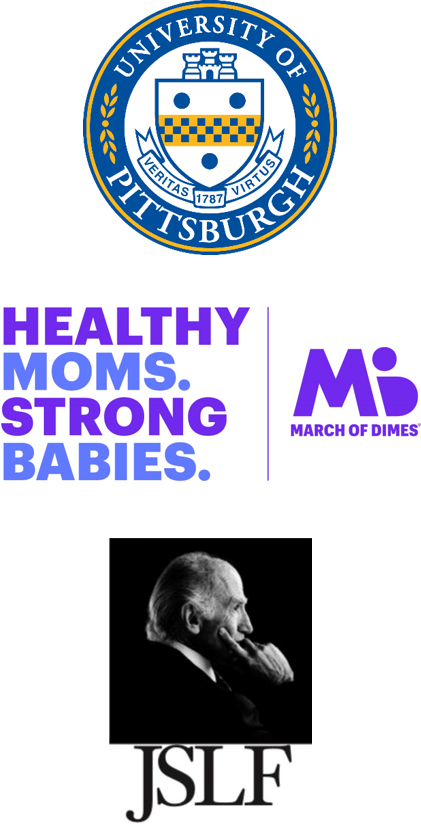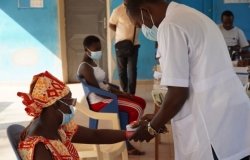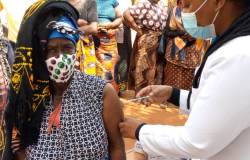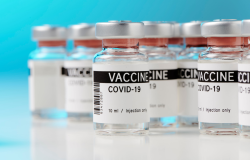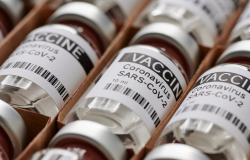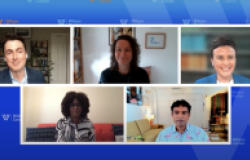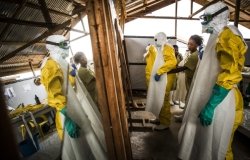Foto 1690179541/Shutterstock.com
Rolling out a Vaccine for COVID-19: Present Prospects and Lessons from the Past
The Wilson Center’s Maternal Health Initiative, in partnership with the University of Pittsburgh, March of Dimes, and the Jonas Salk Legacy Foundation, hosted a discussion with scientists and researchers on ongoing COVID-19 vaccine development initiatives; current challenges and public trust in the process; crucial lessons from previous vaccine development efforts; and questions about safe and equitable distribution, availability, access, and uptake.
Overview
“I think we have to remember not to forget what these diseases did in the past and to actively collaborate, to work with each other, and to communicate well that vaccines work,” said Dr. Paul Duprex, Director of Pitt’s Center for Vaccine Research and Professor of Microbiology and Molecular Genetics at a recent Wilson Center event on the development of a COVID-19 vaccine, co-sponsored by the University of Pittsburgh (Pitt), March of Dimes, and the Jonas Salk Legacy Foundation.
As of October 2020, COVID-19 has infected more than 38 million people and caused more than 1 million deaths worldwide. This massive human toll has made finding a vaccine a global priority. It has also challenged our collective conceptions of how, and at what pace, this process should proceed. Historically, vaccines take years of research and testing before being rolled out to the public, but the urgency of COVID-19 has pushed scientists to compress this process as much as possible, said Sarah B. Barnes, Project Director for the Wilson Center’s Maternal Health Initiative.
Precedent and Process: Lessons from Polio
Although the current moment is unique, it is not entirely unprecedented. During the 1950s, the world found itself in a similar situation. Polio was ravaging the globe, afflicting more than 600,000 people. After a decades-long struggle, the tides eventually turned in the fight against polio when Dr. Jonas Salk’s team at the University of Pittsburgh, with support from March of Dimes, developed the first successful vaccine. At that moment, a “great fear” was lifted, said Dr. Peter Salk, President of the Jonas Salk Legacy Foundation, Professor of Infectious Diseases and Microbiology at Pitt’s Graduate School of Public Health, and son of Dr. Jonas Salk.
There are differences between now and the 1950s, said Duprex. Nevertheless, much can be learned from this precedent, he said. It shows how a disease can be pushed to the edge of eradication by safe, efficacious vaccines.
In our increasingly polarized political climate, reliance on process is especially important, said Dr. Rahul Gupta, Senior Vice President and Chief Medical and Health Officer and Interim Chief Scientific Officer of Research & Global Programs at March of Dimes. It protects vaccine development from the influence of partisan interests and helps assure the public that the result is safe and effective, he said. “We have all of the building blocks to support and sustain rigorous, careful, and ethical evaluation, regulation, and deployment of COVID-19 vaccines, as long as we don’t allow political considerations to derail the process,” said Dr. Ruth A. Karron, Director of the Center for Immunization Research and the Johns Hopkins Vaccine Initiative.
“What we cannot do is rush that development process,” said Duprex. Following the process, without cutting corners, is critical to producing a safe vaccine, he said. It provides a foundation to guide current vaccine efforts and an objective standard to judge their results. When appropriately managed, vaccines will be safe, said Salk.
Pauses in highly anticipated COVID-19 vaccine trials prove that this process is working. “Science is actually holding court and preventing people from rushing things that aren’t ready yet,” said Dr. Anantha Shekhar, Pitt’s Senior Vice Chancellor for the Health Sciences and the John and Gertrude Petersen Dean of the School of Medicine.
Equity in Vaccine Development and Distribution
Promoting equity in the vaccine process is also important, panelists agreed. This begins in vaccine development. Trials must include individuals from various racial, ethnic, and age groups to ensure that the vaccine works in all populations. Another high-risk group notably missing from COVID-19 vaccine trials is pregnant women. “If we don’t yet have data from carefully conducted trials that deliberately include pregnant women, we will need a plan to protect pregnant women in these priority groups when [a] vaccine becomes available late this year or early next year,” said Karron.
Equity is also integral to distribution, said Karron and Gupta. Once a vaccine is approved, it will take time to manufacture, and we must figure out how to allocate the initial limited supply in an equitable manner, said Gupta. This would involve phased distribution, where the vaccine is given to frontline workers and high-risk groups before being distributed to the general public.
The disparate impacts of COVID-19 must also be considered. In the United States, COVID-19 mortality rates are twice as high among communities of color compared to white populations. Health inequities are avoidable, unfair, and unjust, said Dr. Lisa Waddell, Chief Medical Officer of COVID-19 Emergency Response at the Centers for Disease Control and Prevention Foundation, and we should absolutely be outraged. To reckon with these inequities, she said, we must account for the structural barriers that may prevent individuals from accessing the vaccine, such as a lack of insurance. Addressing these social determinants of health is vital, because they affect how individuals respond to public health guidelines, said Waddell.
Earning Public Trust
“Our processes are in place, our science is good, and is global, and can deliver,” said Shekhar. However, even with these development and distribution processes in place, a vaccine candidate will not be successful if it is not trusted and accepted by the public, he said. According to the World Health Organization, vaccine hesitancy is one of the top ten threats to global health, said Waddell. Addressing hesitancy is especially critical to ensuring uptake in vulnerable populations, including communities of color.
Hesitancy should not be dismissed as anti-science or even anti-vaccine, said Gupta. Vaccine hesitancy is to be expected, he said. It is normal for average citizens and residents to question the vaccine before they take it into their bodies.
Hesitancy can be addressed by communicating with the public clearly, early, and often about the process, said Waddell. “What we say matters, and how we say it matters,” she said. This is especially true regarding communities of color, many of which have well-founded concerns, given the “sordid history” in the United States of unethical medical studies involving these communities, said Gupta. Collaborating with individuals in these communities to develop and deploy public health messaging is crucial. “We have to rely on trusted messengers,” said Waddell.
Collaboration is Critical
Many of the issues we face today, from ensuring safety and equity to cultivating public trust, are the same ones the senior Dr. Salk’s team faced in the 1950s. However, there is a key difference. What has changed is now there is extraordinary commitment and coordination and cooperation across the globe, said Shekhar, citing the more than 160 ongoing vaccine candidates being tried globally.
It is this commitment to collaboration—to working together, to learning across time and space—that will enable us to meet the challenges of the current moment. This idea of connection hearkens back to the city where Dr. Salk’s team developed the first polio vaccine all those years ago. “Pittsburgh is a city of bridges,” said Duprex. “Collaboration is critical. Building bridges between groups, across nations, is vital.”
Sources: Centers for Disease Control and Prevention, Jonas Salk Legacy Foundation, March of Dimes, University of Pittsburgh.
Written by Sara Matthews, edited by Sandra Yin
Continue the conversation on Twitter by following @Wilson_MHI. Find more coverage of these issues on our blog, NewSecurityBeat.com/dot-mom.
Documents & Downloads
Speakers
Dr. Peter L. Salk
Dr. Anantha Shekhar
Panelists
Dr. Paul Duprex
Dr. Rahul Gupta
Dr. Ruth A. Karron
Dr. Lisa Waddell
Hosted By

Maternal Health Initiative
Life and health are the most basic human rights, yet disparities between and within countries continue to grow. No single solution or institution can address the variety of health concerns the world faces. By leveraging, building on, and coordinating the Wilson Center’s strong regional and cross-cutting programming, the Maternal Health Initiative (MHI) promotes dialogue and understanding among practitioners, scholars, community leaders, and policymakers. Read more
Thank you for your interest in this event. Please send any feedback or questions to our Events staff.
